Geospatial Analytics for Preliminarily Landscape Active Tectonic Assessment of the Wadi Araba Basin, Western Gulf of Suez, Egypt
Abstract
:1. Introduction
2. Study Area
3. Materials and Methods
3.1. Data
3.2. Morph-Tectonic Analysis
3.2.1. Rock Strength Index
3.2.2. Stream Length Gradient Index (SL)
3.2.3. Mountain Front Sinuosity Index (Smf)
3.2.4. Valley Floor Width to Valley Height Ratio Index (Vf)
4. Results
4.1. Rock Strength Index
4.2. Stream Length Gradient Index (SL)
4.3. Mountain Front Sinuosity (Smf) Index
4.4. Valley Floor Width to Valley Height Ratio Index (Vf)
5. Discussion
6. Conclusions
Author Contributions
Funding
Data Availability Statement
Acknowledgments
Conflicts of Interest
References
- Yildirim, C. Relative Tectonic Activity Assessment of the Tuz Gölü Fault Zone Central Anatolia, Turkey. Tectonophysics 2014, 630, 183–192. [Google Scholar] [CrossRef]
- Bull, W.B.; McFadden, L.D. Tectonic Geomorphology North and South of the Garlock Fault, California. In Geomorphology in Arid Regions. Proceedings of the Eighth Annual Geomorphology Symposium, 23–24 September 1977, Binghamton, NY, USA; Doehring, D.O., Ed.; State University of New York: Albany, NY, USA, 1977; pp. 559–589. [Google Scholar]
- Rockwell, T.K.; Keller, E.A.; Johnson Donald, L. Tectonic Geomorphology of Alluvial Fans and Mountain Fronts near Ventura, California. In Tectonic Geomorphology. Proceedings of the 15th Annual Geomorphology Symposium, 15–26 September 2022; Allen and Unwin Publishers: Boston, MA, USA, 1985; pp. 183–207. [Google Scholar]
- Khalifa, A.; Çakir, Z.; Owen, L.A.; Kaya. Evaluation of the Relative Tectonic Activity of the Adıyaman Fault within the Arabian-Anatolian Plate Boundary (Eastern Turkey). Geol. Acta 2019, 17, 1–17. [Google Scholar] [CrossRef] [Green Version]
- Dumont, J.F.; Santana, E.; Vilema, W. Morphologic Evidence of Active Motion of the Zambapala Fault, Gulf of Guayaquil (Ecuador). Geomorphology 2005, 65, 223–239. [Google Scholar] [CrossRef]
- Molin, P.; Pazzaglia, F.J.; Dramis, F. Geomorphic Expression of Active Tectonics in a Rapidly-Deforming Forearc, Sila Massif, Calabria, Southern Italy. Am. J. Sci. 2004, 304, 559–589. [Google Scholar] [CrossRef]
- Gordon, R.G. THE PLATE TECTONIC APPROXIMATION: Plate Nonrigidity, Diffuse Plate Boundaries, and Global Plate Reconstructions. Annu. Rev. Earth Planet. Sci. 1998, 26, 615–642. [Google Scholar] [CrossRef]
- Mahmood, S.A.; Gloaguen, R. Appraisal of Active Tectonics in Hindu Kush: Insights from DEM Derived Geomorphic Indices and Drainage Analysis. Geosci. Front. 2012, 3, 407–428. [Google Scholar] [CrossRef]
- Khalifa, A. Preliminary Active Tectonic Assessment of Wadi Ghoweiba Catchment, Gulf of Suez Rift, Egypt, Integration of Remote Sensing, Tectonic Geomorphology, and Gis Techniques. Al-Azhar Bull. Sci. 2020, 31, 35–42. [Google Scholar] [CrossRef]
- Baruah, M.P.; Bezbaruah, D.; Goswami, T.K. Active Tectonics Deduced from Geomorphic Indices and Its Implication on Economic Development of Water Resources in South-Eastern Part of Mikir Massif, Assam, India. Geol. Ecol. Landsc. 2020, 6, 99–112. [Google Scholar] [CrossRef]
- El Hamdouni, R.; Irigaray, C.; Fernández, T.; Chacón, J.; Keller, E.A. Assessment of Relative Active Tectonics, Southwest Border of the Sierra Nevada (Southern Spain). Geomorphology 2008, 96, 150–173. [Google Scholar] [CrossRef]
- Wells, S.G.; Bullard, T.F.; Menges, C.M.; Drake, P.G.; Karas, P.A.; Kelson, K.I.; Ritter, J.B.; Wesling, J.R. Regional variations in tectonic geomorphology along a segmented convergent plate boundary, pacific coast of costa rica. Geomorphology 1988, 1, 239–265. [Google Scholar] [CrossRef]
- Medina-Cascales, I.; García-Tortosa, F.J.; Martin-Rojas, I.; Pérez-Peña, J.V.; Alfaro, P. Tectonic Geomorphology of an Active Slow-Moving, Intrabasinal Fault: The Galera Fault (Guadix-Baza Basin, Central Betic Cordillera, Southern Spain). Geomorphology 2021, 393, 107941. [Google Scholar] [CrossRef]
- Khalifa, A.; Çakir, Z.; Owen, L.A.; Kaya, Ş. Morphotectonic Analysis of the East Anatolian Fault, Turkey. Turk. J. Earth Sci. 2018, 27, 110–126. [Google Scholar] [CrossRef]
- Ul-hadi, S.; Khan, S.D.; Owen, L.A.; Khan, A.S.; Sciences, A. Geomorphic Response to an Active Transpressive Regime: A Case Study along the Chaman Strike-Slip Fault, Western Pakistan. Earth Surf. Process. Landf. 2013, 264, 250–264. [Google Scholar] [CrossRef]
- Bhat, M.A.; Dar, T.; Bali, B.S. Morphotectonic Analysis of Aripal Basin in the North-Western Himalayas (India): An Evaluation of Tectonics Derived from Geomorphic Indices. Quat. Int. 2020, 568, 103–115. [Google Scholar] [CrossRef]
- Sharifi Paichoon, M. Tectonic Geomorphology and Quaternary Evolution of Playas: A Case Study of Ernan Playa, Central Iran. Arab. J. Geosci. 2021, 14, 1–18. [Google Scholar] [CrossRef]
- Khalifa, A.; Bashir, B.; Alsalman, A.; Öğretmen, N. Morpho-Tectonic Assessment of the Abu-Dabbab Area, Eastern Desert, Egypt: Insights from Remote Sensing and Geospatial Analysis. ISPRS Int. J. Geo-Inf. 2021, 10, 784. [Google Scholar] [CrossRef]
- Bosworth, W. Geological Evolution of the Red Sea: Historical Background, Review, and Synthesis; Springer: Berlin/Heidelberg, Germany, 2015; Volume 3. [Google Scholar] [CrossRef]
- Moustafa, A.R. Block Faulting in the Gulf of Suez. In Proceedings of the 5th Egypt Egyptian General Petroleum Company, Cairo, Egypt; 1976. Unpublished work. [Google Scholar]
- Bosworth, W.; Taviani, M.; Rasul, N.M.A. Neotectonics of the Red Sea, Gulf of Suez and Gulf of Aqaba. In Neotectonics of the Red Sea, Gulf of Suez and Gulf of Aqaba; Springer: Cham, Switzerland, 2019; pp. 10–35. [Google Scholar] [CrossRef]
- Said, S.M.; Sakran, S. Geometry and Kinematics of Right-Lateral Transpressional Faults and Growth Folds, the Western Side of the Gulf of Suez, Egypt. Geol. J. 2021, 57, 276–291. [Google Scholar] [CrossRef]
- Moustafa, A.R. Internal Structure and Deformation of an Accommodation Zone in the Northern Part of the Suez Rift. J. Struct. Geol. 1996, 18, 93–107. [Google Scholar] [CrossRef]
- Moustafa, A.R. Controls on the Development and Evolution of Transfer Zones: The Influence of Basement Structure and Sedimentary Thickness in the Suez Rift and Red Sea. J. Struct. Geol. 1997, 19, 755–768. [Google Scholar] [CrossRef]
- Kebeasy, R.M. Seismicity of Egypt. In Geology of Egypt; Said, R., Ed.; A. A. Balkema: Rotterdam, The Netherlands, 1990; pp. 51–59. [Google Scholar]
- Badawy, A. Seismicity of Egypt. Seismol. Res. Lett. 2005, 76, 149–160. [Google Scholar] [CrossRef]
- Alsharhan, A.S.; Salah, M.G. Lithostratigraphy, Sedimentology and Hydrocarbon Habitat of the Pre-Cenomanian Nubian Sandstone in the Gulf of Suez Oil Province, Egypt. GeoArabia 1997, 2, 385–400. [Google Scholar] [CrossRef]
- Corporation, C.; Conoco, G.P.; General Petroleum Corporation. Geological Map of Egypt, Scale 1:500,000; Gebel Hamata: Cairo, Egypt, 1987. [Google Scholar]
- Moustafa, A.R.; Khalil, S.M. Structural Setting and Tectonic Evolution of the Gulf of Suez, NW Red Sea and Gulf of Aqaba Rift Systems. In The Geology of Egypt; Springer: Cham, Switzerland, 2020; pp. 295–342. [Google Scholar] [CrossRef]
- Moustafa, A.R.; Khalil, M.H. Superposed deformation in the northern suez rift, egypt relevance to hydrocarbons exploration. J. Pet. Geol. 1995, 18, 245–266. [Google Scholar] [CrossRef]
- Radaideh, O.M.A.; Grasemann, B.; Melichar, R.; Mosar, J. Detection and Analysis of Morphotectonic Features Utilizing Satellite Remote Sensing and GIS: An Example in SW Jordan. Geomorphology 2016, 275, 58–79. [Google Scholar] [CrossRef] [Green Version]
- Khalifa, A.; Çakır, Z.; Kaya, Ş.; Gabr, S. ASTER Spectral Band Ratios for Lithological Mapping: A Case Study for Measuring Geological Offset along the Erkenek Segment of the East Anatolian Fault Zone, Turkey. Arab. J. Geosci. 2020, 13, 1–8. [Google Scholar] [CrossRef]
- Khalifa, A.; Bashir, B.; Çakir, Z.; Kaya, Ş.; Alsalman, A.; Henaish, A. Paradigm of Geological Mapping of the Adıyaman Fault Zone of Eastern Turkey Using Landsat 8 Remotely Sensed Data Coupled with Pca, Ica, and Mnfa Techniques. ISPRS Int. J. Geo-Inf. 2021, 10, 368. [Google Scholar] [CrossRef]
- Bhattarai, I.; Gani, N.D.; Xue, L. Geomorphological Responses of Rivers to Active Tectonics along the Siwalik Hills, Midwestern Nepalese Himalaya. J. Mt. Sci. 2021, 18, 1268–1294. [Google Scholar] [CrossRef]
- Obeidat, M.; Awawdeh, M.; Al-Hantouli, F. Morphometric Analysis and Prioritisation of Watersheds for Flood Risk Management in Wadi Easal Basin (WEB), Jordan, Using Geospatial Technologies. J. Flood Risk Manag. 2021, 14, e12711. [Google Scholar] [CrossRef]
- Khalifa, A.; Bashir, B.; Alsalman, A.; Bachir, H. Morphometric-Hydro Characterization of the Coastal Line between El-Qussier and Marsa-Alam, Egypt: Preliminary Flood Risk Signatures. Appl. Sci. 2022, 12, 6264. [Google Scholar] [CrossRef]
- Han, Z.; Yang, F.; Li, Y.; Dou, J.; Chen, N.; Hu, G.; Chen, G.; Xu, L. Gis-Based Three-Dimensional Sph Simulation for the 11 April 2018 Yabakei Landslide at Oita Nakatsu, Japan. Water 2021, 13, 3012. [Google Scholar] [CrossRef]
- Selby, M.J. A Rock Mass Strength Classification for Geomorphic Purposes: With Tests from Antarctica and New Zealand. Z. Geomorphol. 1980, 24, 31–51. [Google Scholar] [CrossRef]
- Ezati, M.; Gholami, E. Neotectonics of the Central Kopeh Dagh Drainage Basins, NE Iran. Arab. J. Geosci. 2022, 15, 1–18. [Google Scholar] [CrossRef]
- Hack, J.T. Stream-Profile Analysis and Stream-Gradient Index. J. Res. United States Geol. Surv. 1973, 1, 421–429. [Google Scholar]
- Faghih, A.; Samani, B.; Kusky, T.; Khabazi, S.; Roshanak, R. Geomorphologic Assessment of Relative Tectonic Activity in the Maharlou Lake Basin, Zagros Mountains of Iran. Geol. J. 2012, 47, 30–40. [Google Scholar] [CrossRef]
- Silva, P.G.; Goy, J.L.; Zazo, C.; Bardají, T. Faulth-Generated Mountain Fronts in Southeast Spain: Geomorphologic Assessment of Tectonic and Seismic Activity. Geomorphology 2003, 50, 203–225. [Google Scholar] [CrossRef]
- Badawy, A. Historical Seismicity of Egypt. Acta Geod. Geophys. Hung. 1999, 34, 119–135. [Google Scholar]
- Elliott, J.R.; Copley, A.C.; Holley, R.; Scharer, K.; Parsons, B. The 2011 Mw 7.1 Van (Eastern Turkey) Earthquake. J. Geophys. Res. 2013, 118, 1619–1637. [Google Scholar] [CrossRef]
- Ambraseys, N.N.; Melville, C.P.; Adams, R.D. The Seismicity of Egypt, Arabia and the Red Sea. In The Seismicity of Egypt, Arabia and the Red Sea; University of Cambridge: Cambridge, UK, 1994. [Google Scholar] [CrossRef]
- Hosny, A.; Omar, K.; Ali, S.M. The Gulf of Suez Earthquake, 30 January 2012, Northeast of Egypt. Rend. Lincei 2013, 24, 377–386. [Google Scholar] [CrossRef]



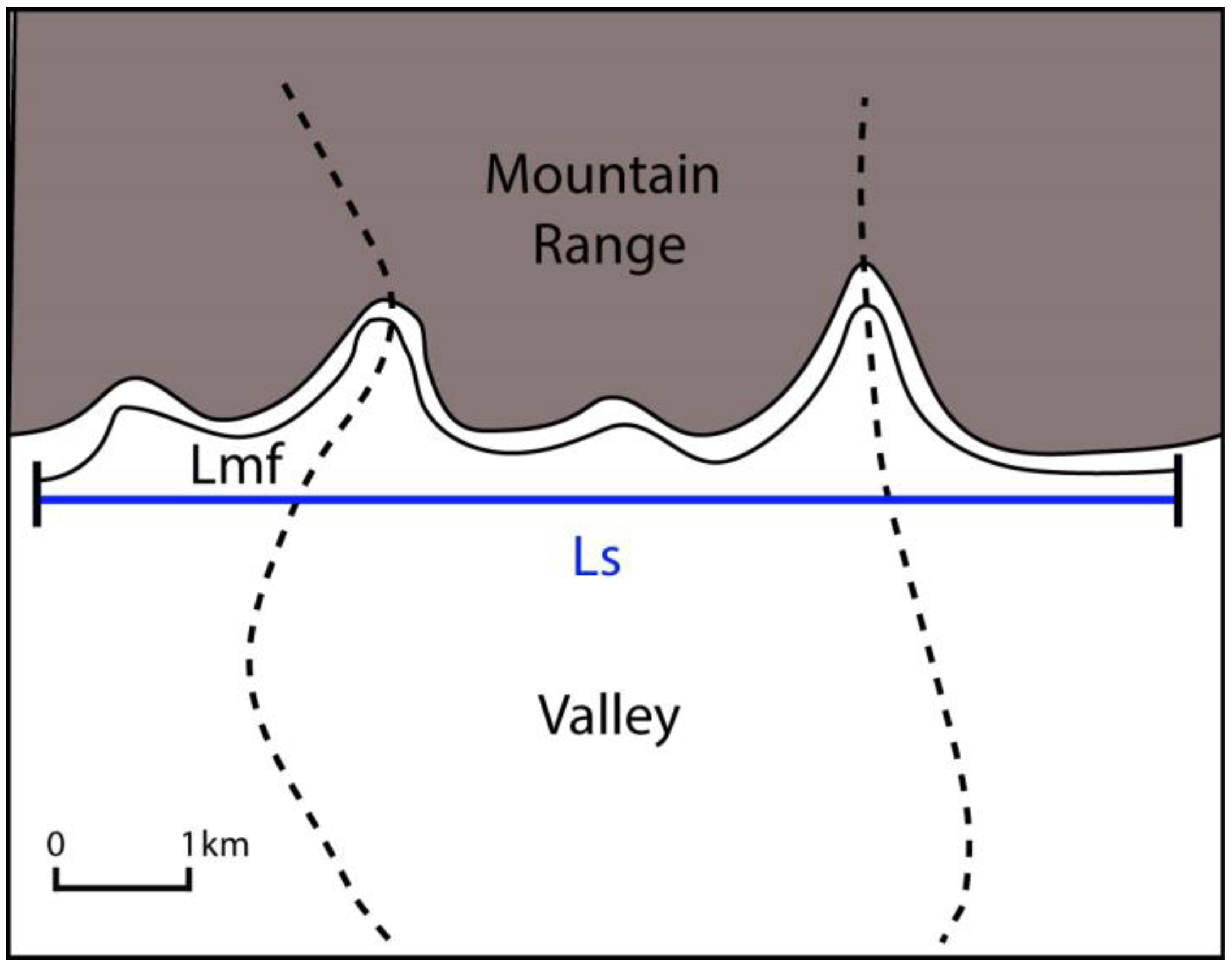
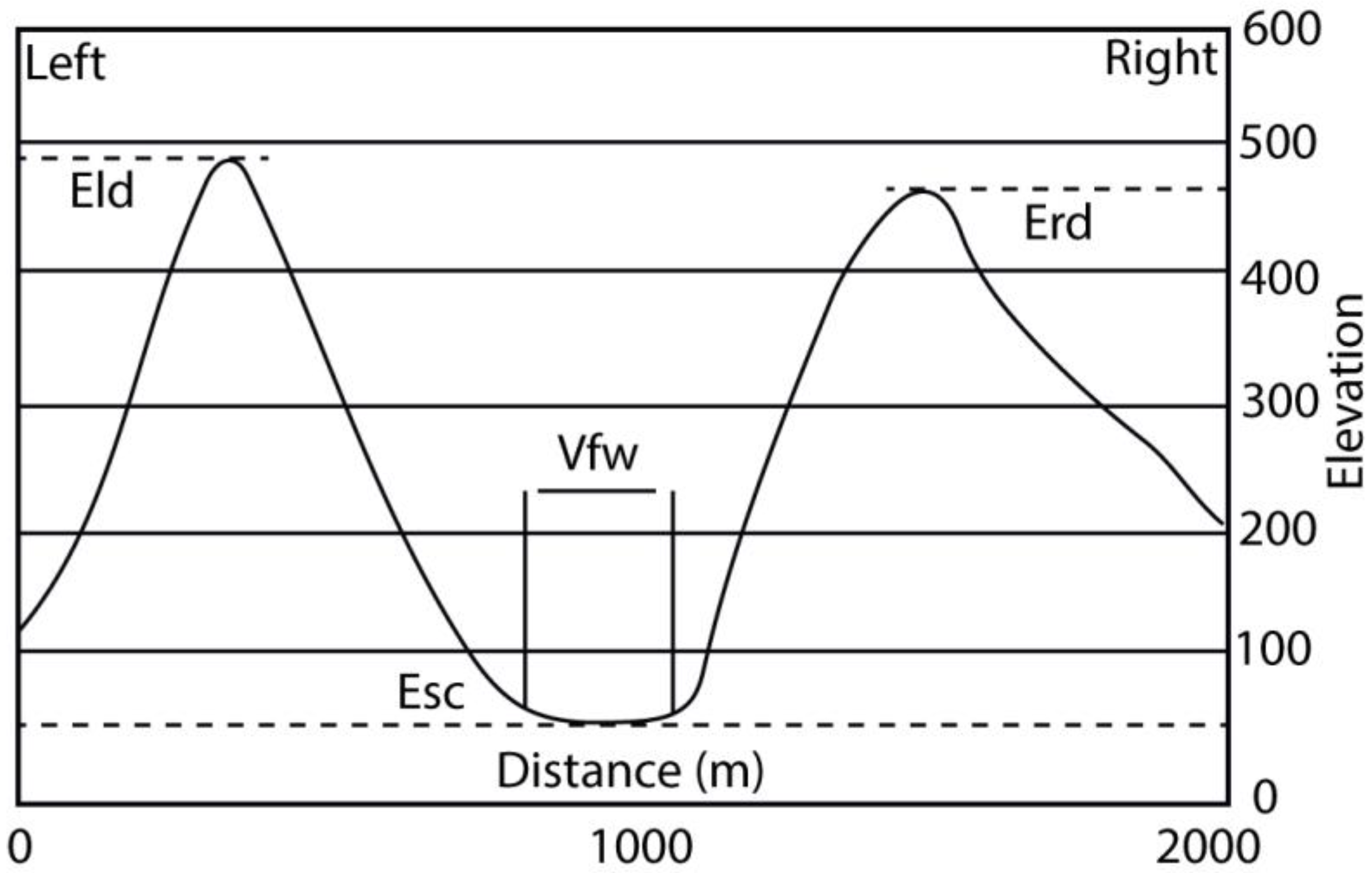
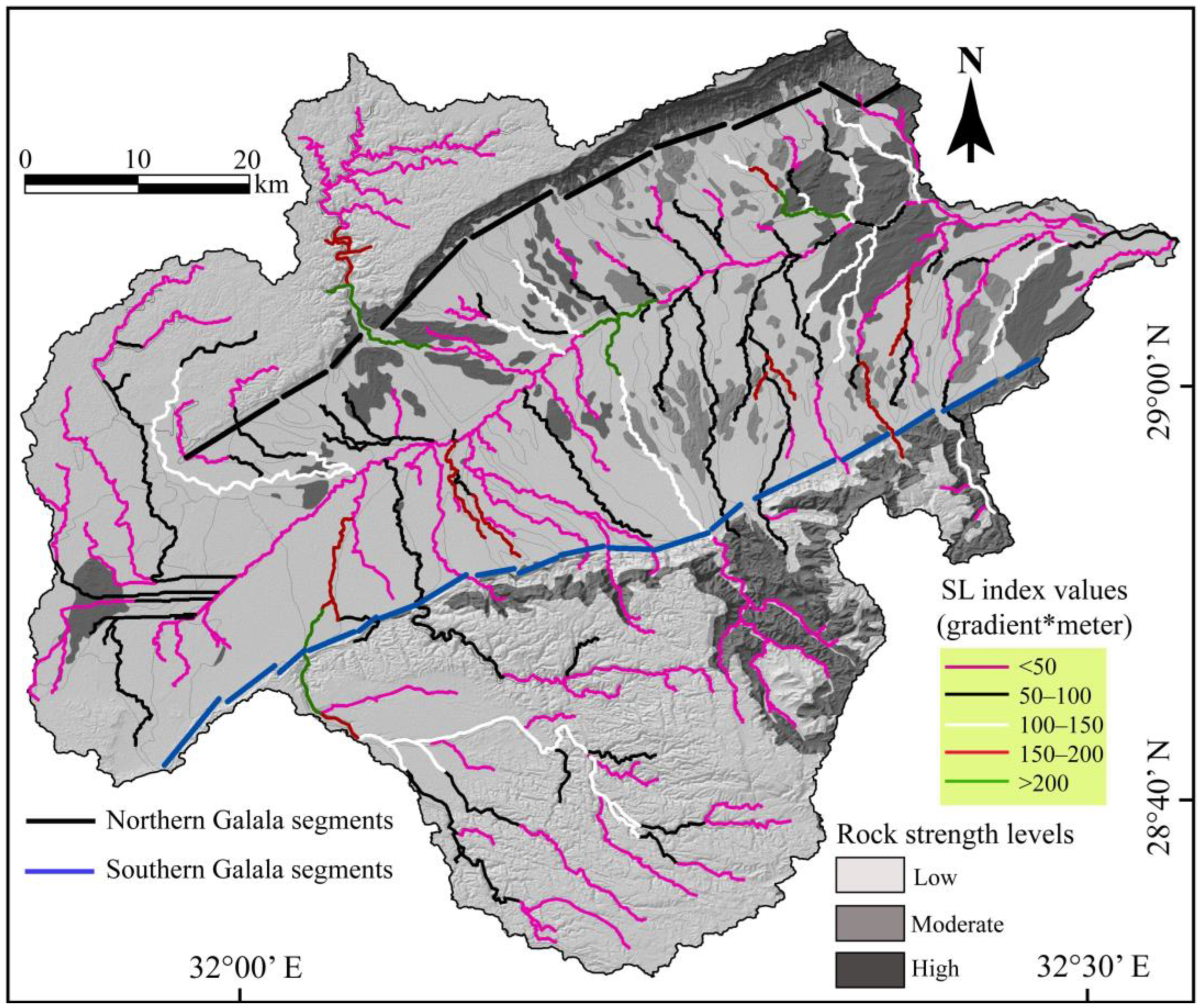
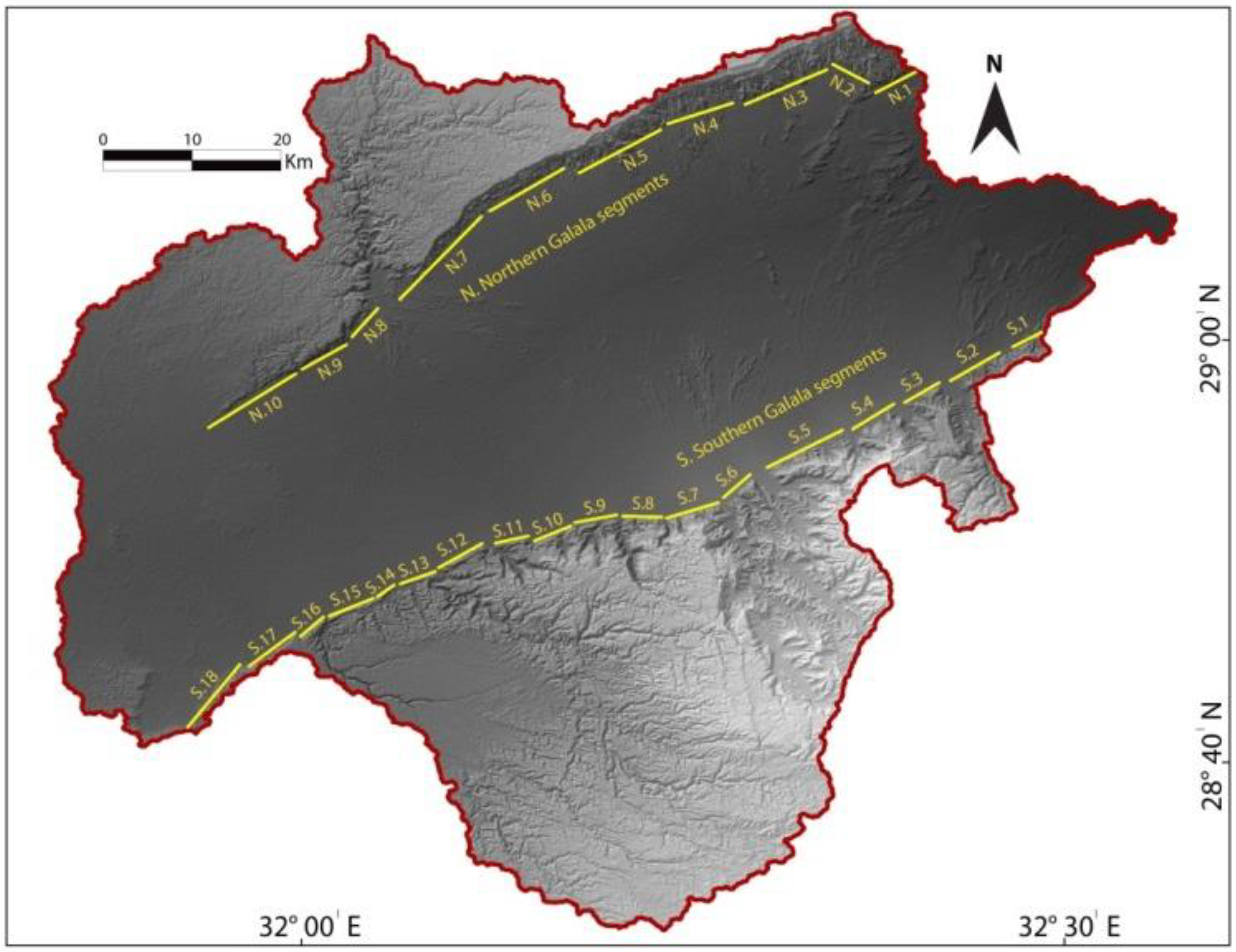
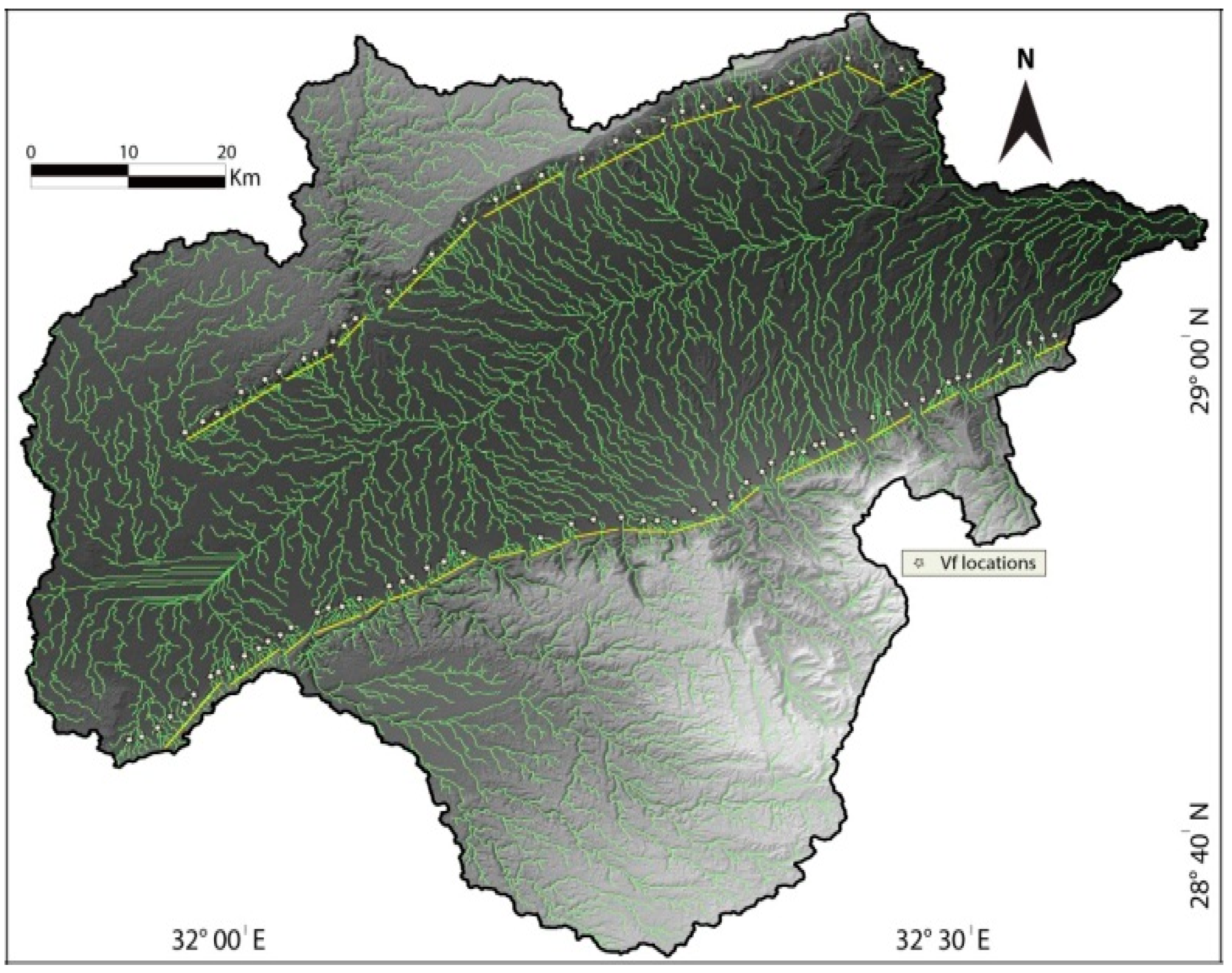
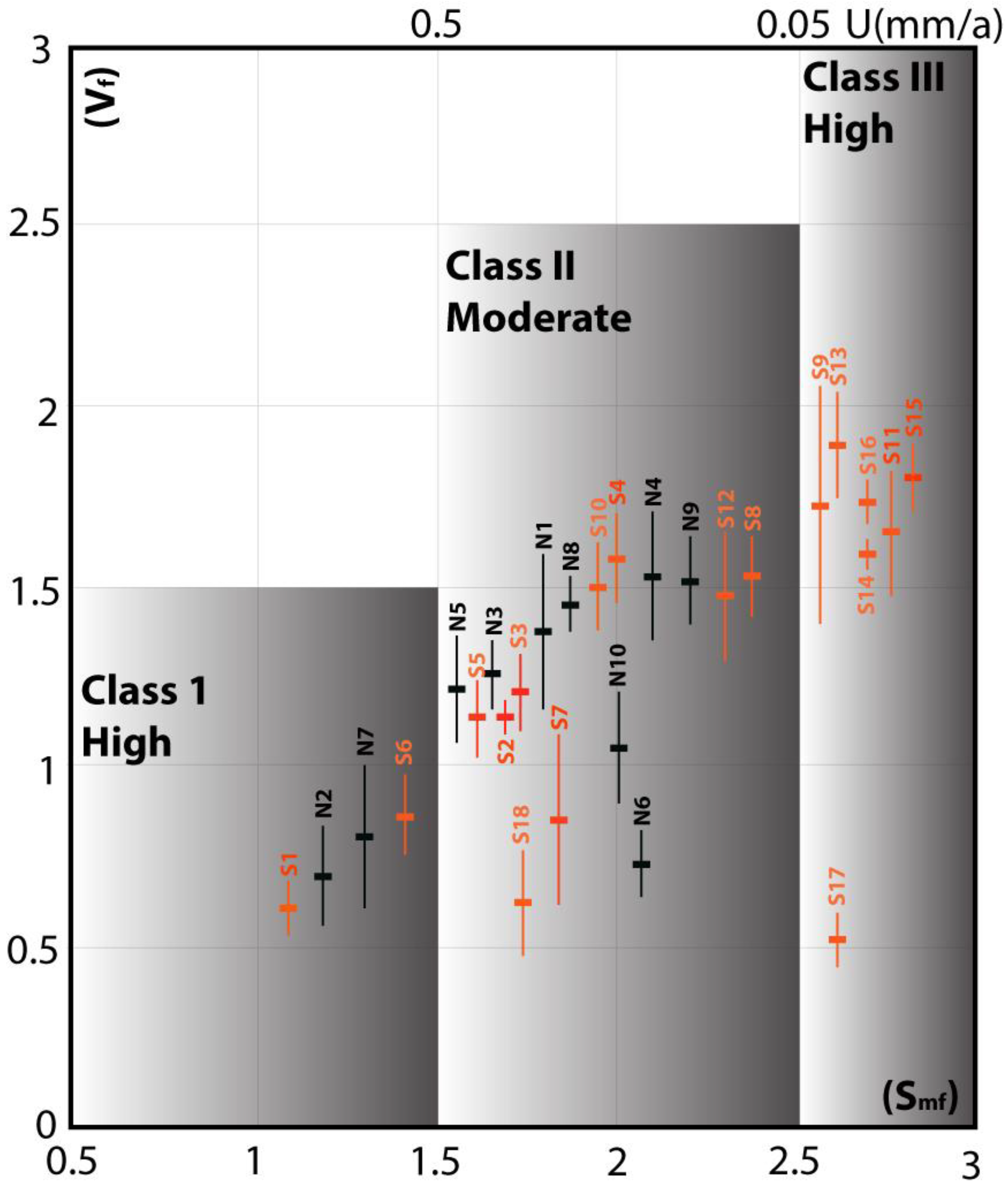
| Mountain Fronts | Smf | Vf | Class |
|---|---|---|---|
| N1 | 1.83 | 1.37 | Moderate |
| N2 | 1.22 | 0.70 | High |
| N3 | 1.65 | 1.26 | Moderate |
| N4 | 2.10 | 1.55 | Moderate |
| N5 | 1.55 | 1.30 | Moderate |
| N6 | 2.11 | 0.72 | Moderate |
| N7 | 1.38 | 0.79 | High |
| N8 | 1.84 | 1.45 | Moderate |
| N9 | 2.21 | 1.51 | Moderate |
| N10 | 2.00 | 1.10 | Moderate |
| S1 | 1.12 | 0.60 | High |
| S2 | 1.70 | 1.67 | Moderate |
| S3 | 1.73 | 1.71 | Moderate |
| S4 | 2.00 | 1.62 | Moderate |
| S5 | 1.61 | 1.70 | Moderate |
| S6 | 1.89 | 0.77 | High |
| S7 | 1.82 | 0.84 | Moderate |
| S8 | 2.38 | 1.56 | Moderate |
| S9 | 2.57 | 1.70 | Low |
| S10 | 1.92 | 1.50 | Moderate |
| S11 | 2.78 | 1.70 | Low |
| S12 | 2.32 | 1.48 | Moderate |
| S13 | 2.61 | 1.81 | Low |
| S14 | 2.69 | 1.65 | Low |
| S15 | 2.83 | 1.74 | Low |
| S16 | 2.69 | 1.75 | Low |
| S17 | 2.60 | 0.53 | Low |
| S18 | 1.70 | 0.71 | Moderate |
Publisher’s Note: MDPI stays neutral with regard to jurisdictional claims in published maps and institutional affiliations. |
© 2022 by the authors. Licensee MDPI, Basel, Switzerland. This article is an open access article distributed under the terms and conditions of the Creative Commons Attribution (CC BY) license (https://creativecommons.org/licenses/by/4.0/).
Share and Cite
Elnobi, M.; Bashir, B.; Alsalman, A.; Bachir, H. Geospatial Analytics for Preliminarily Landscape Active Tectonic Assessment of the Wadi Araba Basin, Western Gulf of Suez, Egypt. Appl. Sci. 2022, 12, 12152. https://doi.org/10.3390/app122312152
Elnobi M, Bashir B, Alsalman A, Bachir H. Geospatial Analytics for Preliminarily Landscape Active Tectonic Assessment of the Wadi Araba Basin, Western Gulf of Suez, Egypt. Applied Sciences. 2022; 12(23):12152. https://doi.org/10.3390/app122312152
Chicago/Turabian StyleElnobi, Mahmoud, Bashar Bashir, Abdullah Alsalman, and Hussein Bachir. 2022. "Geospatial Analytics for Preliminarily Landscape Active Tectonic Assessment of the Wadi Araba Basin, Western Gulf of Suez, Egypt" Applied Sciences 12, no. 23: 12152. https://doi.org/10.3390/app122312152








